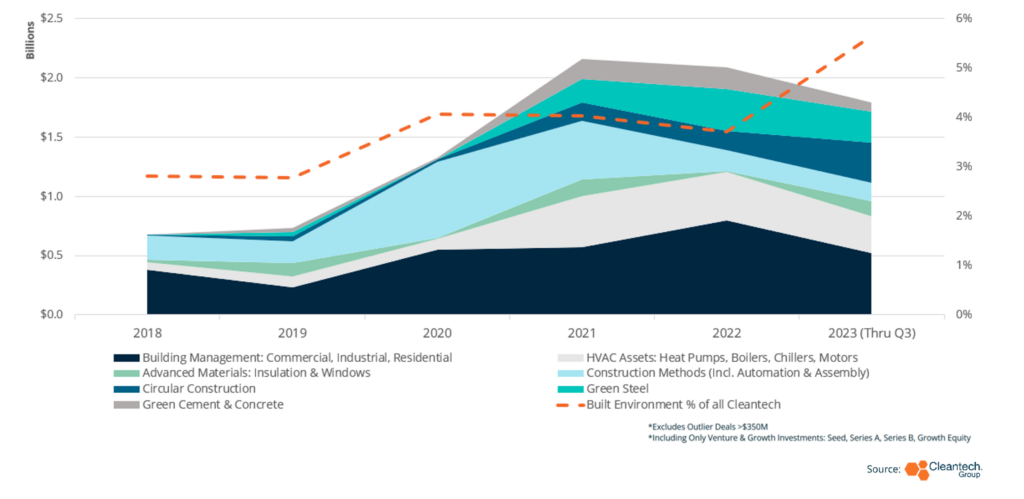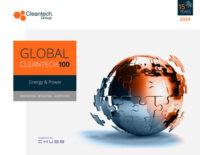Innovation in Built Environment Sustainability
Climate Week NYC offers an unparalleled opportunity (second only to the Cleantech Forum!) to exchange observations with the world’s climate leaders on where trends are emerging and priorities should lie. This year, Cleantech Group had the honor of speaking to a group of stakeholders at JPMorgan Chase & Co. about opportunities in built environment sustainability.
While often thought of in the silo of buildings decarbonization, the theme of technology for built environment sustainability cuts across all industry groups. The growing importance of this theme is being reflected in venture and growth investments in real time (Figure 1). While building management technologies have long underpinned the bulk of built environment investments, hard- and deep-tech innovation in HVAC assets, green steel, and green cement are now increasing, and investments in the built environment comprise a greater percentage of overall cleantech investments than ever before.

This enthusiasm is not a fluke – there are multiple imperatives in the built environment that must be accounted for if net-zero is to be achieved and non-carbon environmental impacts avoided in the coming decades. The moving target of built environment sustainability requires solving for 3 categories of challenges (Figure 2):
- Getting 20% of today’s building stock to net-zero by 2030 – Reaching The IEA’s 2050 net-zero goals will require more than just getting new builds right; drawing down energy consumption in today’s buildings will be a core part of the solution mix.
- Building for two billion more – By 2050, population growth (estimated at over two billion) will motivate construction of massive swaths of new buildings. In the U.S. alone, it’s estimated that by 2030 nearly half of the country’s building stock will have been built since 2006.
- Denser, hotter cities – A 2018 UN estimate predicted that urban centers would move from holding 55% of the world’s population to 68% by 2050. Energy demands coming from within buildings will be heavier than ever and multiplied across far more buildings that are in close proximity to each other.

20% Net-Zero by 2030
While there is much enthusiasm around technologies that can optimize sophisticated buildings, including frictionless SaaS offerings to optimize building management systems (BMS), solutions need to be deployed to the 40% of floor space that was built before 1980. Put another way – we need to make dumb buildings smart.
“Drop-in” HVAC Efficiency
Solutions that can be installed into buildings with little-to-no retrofitting are one of the lowest-hanging fruits to decarbonize today’s building stock. Some examples include:
- Flair Vents: Programmable and automatable smart vents that allow for room-by-room control or to throttle air flow in different “zones” of rooms, potential for up to 30% energy savings.
- Easy-install heat pumps, requiring no retrofitting, offering the benefits of heat pumps (lower electricity usage, no refrigerants) at only the cost of the device (see Gradient).
HVAC Priority Asset Optimization
Distinct from broader trends of generalist building management systems, technologies are emerging that specialize in making traditionally “dumb” heating and cooling devices smart – bringing otherwise manually-controlled devices into the digitalization fold.
- Runwise: Wireless sensors and IoT system to bring traditionally manual devices into automation schemes, including specialized applications for boilers.
- Ecosync: Intelligent radiator valve actuators for easy, no-wiring installation. Brings radiators into building management schemes and avoids overuse / wasted use, especially effective in large buildings (e.g., hotels – solution includes a room booking system integration) with many radiators to manage at once.
Reinventing the Core
Despite the improving availability of drop-in solutions, large buildings especially will require deeper retrofits to existing equipment to hollow out energy use and operating costs. Innovators are now taking aim at the most energy-intensive components of HVAC systems and swapping them out for more efficient technologies.
Perhaps the most obvious example in recent years has been that of Turntide Technologies, who has reinvented the electric motors that HVAC systems rely on to move air through rooftop units and air handling units. Managed by Turntide’s smart controllers, the company’s motors use precise pulses of power, versus consistent currents, to run at optimal speeds with minimal energy usage. Furthermore, Turntide has engineered rare earth metals out of the devices, offering more predictable supply chain stability long term.
As heat pumps become more ubiquitous in buildings around the world, technologies aimed at improving efficiency and avoiding use of toxic fluids are beginning to take shape. Thermoacousic compression, involving use of acoustic waves to compress or expand a gas, typically helium, can generate heating and cooling effects without refrigerants. Emerging innovators such as Equium and Blue Heart have developed thermoacoustic compressors that can be integrated into OEM devices modularly or can be directly retrofitted into heat pumps already in operation.
Tack-on Materials Solutions
Discussions of materials within the context of buildings sustainability tends to evoke images of walls being knocked down and drop-ceilings ripped out, however, promising new technologies are promising to bump building efficiency up a significant step, without need for deep retrofits.
Phase change materials – materials that are engineered to a specific melt / freeze point – allow a unique opportunity to trap and release heat efficiently, tailored to specific comfort temperatures and as a result, requiring fewer fluctuations in indoor temperatures. Phase Change Solutions has innovated a unique phase change paneling solution that can be installed externally onto a wall, bringing the benefits of phase change materials to room interiors in a few hours versus over the course of a lengthy retrofit.
Albotherm, a UK-based innovator in glass coatings, is making today’s windows smart without replacing them. Albotherm’s nano-engineered window coatings are “tuned” to a specific lightening and darkening temperature in order to absorb or reject heat.
Up Next: Building for Two Billion More
Want to continue the conversation? Join our Built Environment Executive Summit in partnership with JP Morgan at the 2024 Cleantech Forum North America this January in San Diego.e



